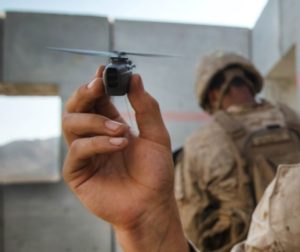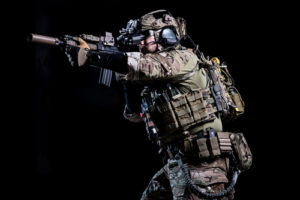The most straightforward application of Dark Signal Research technologies is in the secure storage and transmission of ultra-high resolution digital imagery. Although our cryptographic IP is applicable in the commercial space, our primary focus is in battlefield intelligence and awareness.
BATTLEFIELD INTELLIGENCE
A massive amount of digital intelligence data is actively captured in the modern battlefield. Data encryption is an integral part of any intelligence data gathering and storage system and is therefore always a primary concern. Multispectral sensor arrays and data fusion are driving the next generation of storage requirements. Not only must this “big data” be captured, but it must be securely stored on board intelligence gathering devices or transmitted back to battery powered mobile ground stations. The real challenge in this space is the fact that drones are getting smaller and smaller yet data sets are constantly increasing in size. Dark Signal Research technologies may be the key in solving these problems and ensuring field viability.
Intelligence Gathering Swarms
UAV sensor networks are emerging as an inexpensive and effective method of gathering intelligence data. Traditionally these types of networks only supported low resolution video at a limited frame rate and operated without encryption. Support for ultra-high resolution digital imagery is the goal of next generation technologies. The sheer size of collected data makes it difficult to secure in power and weight constrained environments.
Current commercial and government efforts are exploring the possibility of operating wireless sensor networks as entities analogous to a biological population, with individual nodes mapping to individual organisms and network architecture mapping to the population. Modeled after flying insects, these networks consist of hundreds or more microchip-driven nodes with appropriate scale to realize winged flight. Small and extremely light weight digital cameras provide vision for these insect sized drones. Research on devices of this scale is underway at the Wyss Institute at Harvard University.
Power for microscale UAVs is typically supplied via tiny lithium polymer cells. Small low-power embedded processors are a fundamental requirement, since most of the power is used to control the sensor, communicate control data to other sensors, and integrate with ground stations. If large sets of intelligence imagery are to be recorded onboard, it must be encrypted as a countermeasure against battlefield loss. If imagery is to be transmitted back to a ground station, it must be encrypted while on a wireless network. Battery power and weight have surfaced as the most challenging problems to solve if these types of systems are to become viable.
Problems
- How do you secure microscale UAVs that need to process massive amounts of data without increasing onboard computational requirements?
- How do you make your security architecture completely independent of algorithms and hardware in case new government (NIST/NSA) standards emerge?
Solution
Patented Dark Signal Research technology can replace heavy chemical cells with light weight storage devices using cryptographically structured data during the storage initialization phase. Please see our Technologies section for an overview of how this is realized.
BATTLEFIELD AWARENESS AND TARGET SELECTION
Next generation environmental sensing and targeting systems are exploring multispectral sensor fusion for warfighter awareness and precision targeting. Some of the more interesting technologies are advanced projection systems giving the warfighter a comprehensive three-dimensional view of the battlefield and small scale targeting systems.
These types of systems are often processor constrained, since they are required to execute complex targeting algorithms that are computationally intensive. The addition of hardware encryption to process ultra-high resolution digital video can both be a costly endeavor and add unnecessary complexity to system circuitry. Next generation night vision is an example of such a technology essential to warfighter survival and maintaining our advantage over U.S. adversaries. Since batteries are often the heaviest items in handheld battlefield components, a night vision goggle or targeting device should have the smallest battery possible.
Problems
- How do you secure big data collected by multispectral sensor arrays, when almost all processor resources are being used for digital image processing and target selection?
- How do you secure real time communication links between sensors or weapons operating in tactical mode under hard real time processing constraints?
Solution
Patented Dark Signal Research technology addresses this problem and enables the encrypted recording or transmission of large data sets, even with severely constrained processor resources and the tiny footprint often found in handheld optical and targeting devices.
BATTLEFIELD COMMUNICATIONS
Secure Real Time Digital Video Links
Cryptographic jitter is analogous to audio or video jitter that may be experienced on a bandwidth constrained communication links. Even though a link may have sufficient bandwidth for unencrypted audio and video transmission, the time to encrypt and decrypt data can introduce delays that impair information comprehension by the warfighter. This problem is exacerbated by the fact that next generation systems often collect and large amounts of digital data and are mobile in nature.
- In processor constrained environments, how do you prevent cryptographic jitter when encrypting and transmitting real time ultra-high resolution video?
- In processor constrained environments, how do you prevent cryptographic jitter when receiving and decrypting real time ultra-high resolution video?
Solution
Patented Dark Signal Research technology addresses this problem and enables encrypted links for ultra-high resolution digital imagery using standard wireless protocols. The goal is to use NSA approved Suite B algorithms without having to resort to high cost NSA certified devices. By utilizing algorithms such as AES, Suite B encryption systems have become more standardized, less expensive, and easier to develop. Suite B compliant communication links and storage systems are approved for the processing of classified data.

